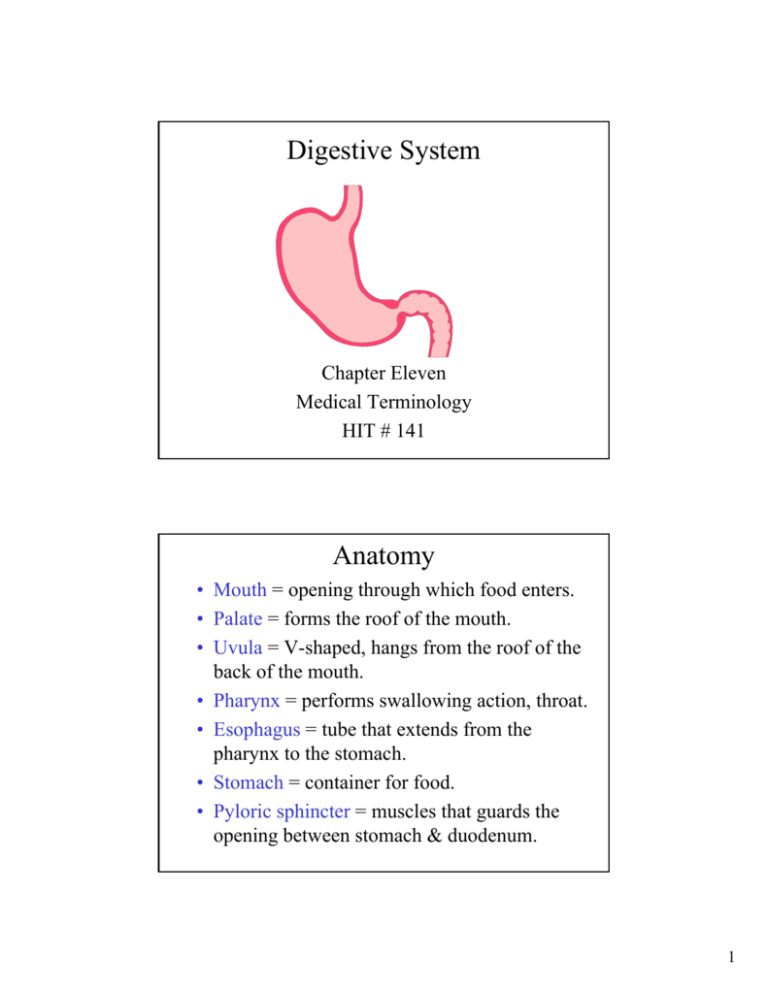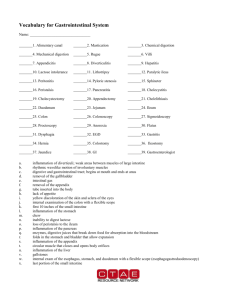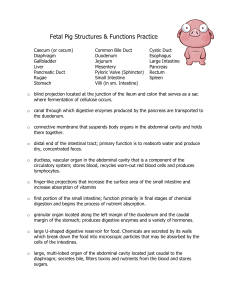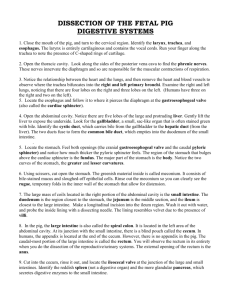Digestive System Anatomy
advertisement

Digestive System Chapter Eleven Medical Terminology HIT # 141 Anatomy • Mouth = opening through which food enters. • Palate = forms the roof of the mouth. • Uvula = V-shaped, hangs from the roof of the back of the mouth. • Pharynx = performs swallowing action, throat. • Esophagus = tube that extends from the pharynx to the stomach. • Stomach = container for food. • Pyloric sphincter = muscles that guards the opening between stomach & duodenum. 1 Anatomy • Small intestine = 20 foot, from pyloric sphincter to the large intestine. • Duodenum = first part of the small intestine. • Jejunum = second part of the small intestine. • Ileum = third part of the small intestine. • Large intestine = 5 feet from ileum to anus. • Cecum = first part of large intestine. • Colon = second part of large intestine. • Rectum = third part of large intestine. • Anus = sphincter muscle, end of digestive tract. Accessory organs • Salivary glands = produce saliva in mouth. • Liver = produces bile, digestion of fats. • Bile ducts = passageways that carry bile, hepatic duct from liver, cystic duct from gallbladder. Form common bile duct empties into duodenum. • Gallbladder = small, structure, stores bile. • Pancreas = pancreatic juice aids in digestion and insulin for carbohydrate metabolism. • Appendix = has no known function. • Peritoneum = lining of the abdominal & pelvic cavities. 2 Combining Forms, Digestive Tact • • • • • • • • • • An/o = anus. Antr/o = antrum. Cec/o = cecum. Col/o = colon. Duoden/o = duodenum. Enter/o = intestine. Esophag/o = esophagus. Appendic/o = appendix. Cheil/o = lip. Chol/e = gall, bile. Combining Forms, Digestive Tact • • • • • • • Cholangi/o = bile duct. Choledoch/o = common bile duct. Diverticul/o = diverticulum or blind pouch. Gingiv/o = gum. Gloss/o lingu/o = tongue. Hepat/o = liver. Herni/o = hernia, protrusion of an organ through a body wall. • Lapar/o abdomin/o celi/o = abdomen. • Palat/o palate. 3 Combining Forms, Digestive Tact • • • • Pnacreat/o = pancreas. Peritone/o = peritoneum. Pylor/o = polyp, small growth. Sial/o = saliva, salivary gland. Disease and Disorder Terms • • • • • • • • Appendicitis = inflammation of the appendix. Cholangioma = tumor of the bile duct. Cholecystitis = inflammation of the gallbladder. Choledocholithiasis = stones in the common bile duct. Cholelithiasis = condition of gallstones. Diverticulitis = inflammation of the diverticulum. Gastritis = inflammation of the stomach. Gastroenteritis = inflammation of the stomach and intestines. 4 Disease and Disorder Terms • • • • • • Gingivitis = inflammation of the gums. Hepatitis = inflammation of the liver. Hepatoma = tumor of the liver. Palatitis = inflammation of the palate. Pancreatitis = inflammation of the pancreas. Polyposis = condition of polyps in the mucous, intestine. • Proctoptosis = prolapse of the rectum. • Rectocele = protrusion of the rectum. • Sialolith = stone in the salivary gland. Disease and Disorder Terms • Adhesion = growing together of two surfaces, after surgery. • Anorexia nervosa = psychoneurotic disorder, prolonged refusal to eat. • Bulimia = gorging with food then vomiting. • Cirrhosis = chronic disease of the liver, caused by alcoholism. • Crohn’s disease = chronic inflammation, of the ileum also regional enteritis. • Gastric ulcer = ulcer in the stomach. 5 Disease and Disorder Terms • Ileus = obstruction of the intestine. • Intussusception = telescoping of a segment of the intestine. • Irritable bowel syndrome = periodic disturbances of bowel function, diarrhea or constipation with abdominal pain. • Polyp = tumor like growth from a mucous membrane. • Ulcerative colitis = inflammation of the colon with formation of ulcers. • Volvulus = twisting of kinking of intestine, causing obstruction. Surgical Terms • • • • • • • Abdominoplasty = surgical repair of the abdomen. Anoplasty = surgical repair of the anus. Appendectomy = excision of the appendix. Celiotomy = incision into the abdominal cavity. Cholecystectomy = excision of the gallbladder. Colectomy = excision of the colon. Colostomy = artificial opening into the colon through the abdominal wall, to pass stool. • Diverticulectomy = excision of a diverticulum. • Enterorrhaphy = suture of the intestine. 6 Surgical Terms • Gastrectomy = excision of the stomach. • Gastrostomy = creation of an artificial opening into the stomach, through abdominal wall, when swallowing is impossible. • Glossorrhaphy = suture of the tongue. • Laparotomy = incision into the abdomen. • Polypectomy = excision of a polyp. • Pyloroplasty = surgical repair of the pylorus. • Abdominoperineal = removal of the colon and rectum. Surgical Terms • Anastomosis = surgical connection between two normally distinct structures. • Vagotomy = cutting of branches of the vagus nerve, to reduce amount of gastric acid and reduce the recurrence of ulcers. • Cholangiogram = x-ray film of bile ducts. • Cholecystogram = x-ray film of the gallbladder. • Colonoscope = instrument used for visual examination of the colon. • Colonscopy = visual examination of the colon. 7 Surgical Terms • Endoscope = instrument used for visual examination within a hollow organ. • Esophagogastroduodenscopy = visual examination of the esophagus, stomach, and duodenum. • Esophagoscope = instrument for visual examination of the esophagus. • Gastroscopy = visual examination of the stomach. • Laparoscope = instrument for visual examination of the abdominal cavity. Surgical Terms • Laparoscopy = visual examination of the abdominal cavity. • Proctoscope = instrument used for visual examination of the rectum. • Sigmoidoscopy = visual examination of the sigmoid colon. • Lower GI = x-rays of the large intestine, after a barium enema. • Upper GI = x-rays of the stomach and duodenum after barium has been swallowed. 8 Complementary Terms • • • • • • • • Abdominal = pertaining to the abdomen. Abdominocentesis = puncture to remove fluid. Anal = pertaining to the anus. Apepsia = without, lack of digestion. Aphagia = without, inability to swallow. Dyspepsia = difficult digestion. Gastrodynia = pain in the stomach. Gastroenterolgist = physician who specializes in diseases of the stomach and intestines. • Gastromalacia = softening of the stomach. Complementary Terms • • • • • • • • Glossopathy = disease of the tongue. Nasogastric = pertaining to the nose & stomach. Oral = pertaining to the mouth. Proctologist = physician who specializes in proctology. Proctology = study of rectum and anus. Sublingual = pertaining to under the tongue. Ascites = collection of fluid in the peritoneal cavity. Diarrhea = frequent discharge of liquid stool. 9 Complementary Terms • Feces = waste for the digestive tract, expelled through the rectum, bowel movement. • Flatus = gas in the digestive tract. • Gastric lavage = washing out of the stomach. • Hematemesis = vomiting of blood. • Reflux = return of flow, of stomach contents back through the esophagus. • Vomit = matter expelled from the stomach through the mouth, vomitus or emesis. Abbreviations • • • • • • • • • • BE = barium enema EGD = esophagogastroduodenoscopy EUS = endoscopic ultrasound GB series = gallbladder series GERD = gastroesophageal reflux disease GI = gastrointestinal H. pylori = helicobacter pylori IBS = irritable bowel syndrome. N & V = nausea and vomiting PEG = percutaneous endoscopic gastrostomy 10 End Chapter Eleven TIME TO STUDY 11









